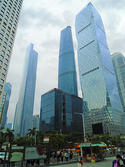The mayor of San Diego wants to spend $177 billion expanding the region’s transit system in order to make San Diego like “Barcelona, Madrid, Paris.” Meanwhile, Barcelona, Madrid, and Paris are becoming more like U.S. cities, at least in terms of the transportation habits of their residents. read more »
Urban Issues
The Twilight of Great American Cities is Here. Can We Stop It?
The dreadful death of George Floyd lit a fire that threatens to burn down America’s cities. Already losing population before the pandemic, our major urban centers have provided ideal kindling for conflagration with massive unemployment, closed businesses and already rising crime rates. read more »
- Login to post comments
How Race Politics Burns Out
No future awaits those who rage against family, work, and community.
Where there is no bread, there is no Law. Where there is no Law, there is no bread.
— Rabbi Elazar Ben Azariah read more »
- Login to post comments
COVID Work Trip Reduction Estimates: CSAs with Transit Legacy Cities
America’s elite central business districts have symbolized the ascendency of big cities, epitomized by soaring office towers. But today, due the COVID-19 pandemic, so much office work performed in these CBDs can be done remotely, that their future seems far less towering than in the past. In contrast, less dense areas, notably exurbs, appear to have suffered less loss in their employment patterns. read more »
- Login to post comments
Chinese Science Fiction's Disaster Dystopias
In Ma Jian’s new novel, the protagonist, Ma Daode, may be a corrupt, womanizing local official, but he is a corrupt, womanizing local official with a mission. His goal is to develop a drug that will allow President Xi Jinping’s vision of a glorious Chinese future to dominate not only citizens’ daily lives but their sleeping hours as well. This is his utopian quest. The China dream, Ma Daode suggests, “is not the selfish, individualist dream chased by Western countries. read more »
- Login to post comments
The Future of Driving
A new study from accounting firm KPMG predicts that auto travel in the United States will be 9 to 10 percent less after the pandemic than it was before. Telecommuting, says the report, will lead to a 10 to 20 percent reduction in commuting by car while on-line shopping will lead to a 10 to 30 percent reduction in shopping trips. read more »
- Login to post comments
In Praise of Streetcar Suburbs, Defined and Illustrated
If there is a single American development pattern or style that I love most, it is the streetcar suburb. Bringing more of this pattern back to our cities would be a great thing. read more »
- Login to post comments
Slower Municipality Growth in China: 2010-2019
China, which many see as the exemplar of rapid urban growth, is accelerating its own shift towards greater dispersion.
During the 2000s, the largest municipalities (formerly called prefectures) of China grew very quickly. Much of this was a result of an increasing “floating population,” people who moved to the cities from rural areas for employment, especially in factories producing goods for export and in construction. Between 2000 and 2010, according to the China Statistical Yearbook: 2019, the floating read more »
- Login to post comments
The Return of White Flight
America’s downtowns, particularly those of the major cities at the heart of large metro regions of over one million people, have seen significant residential development and population growth in the recent years. Downtown Chicago, for example, has nearly 100,000 more residents than it did in the 1980s. Visit almost any downtown and see many nearly identical apartment buildings sprouting. read more »
- Login to post comments
America's Long Suffering Rail Commuters
The long, streaking commuter trains (suburban rail) carrying workers mostly into and out of downtown every day may give the impression of “rapid transit.” However, regardless of the top speeds they reach, the average suburban rail rider spends far more time traveling to work than those using other modes of getting to work (Figure 1). They spend far longer than the majority of commuters, who drive alone. Even in the New York combined statistical area (CSA), with the largest suburban rail network a majority drive to work (Figure 2). read more »






















